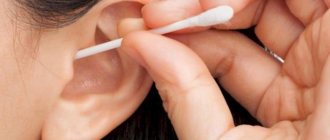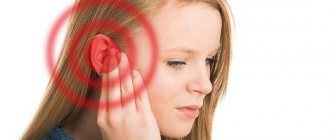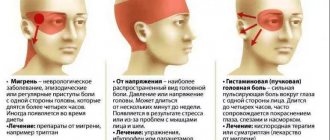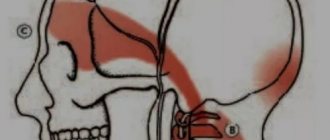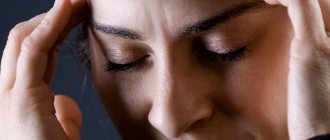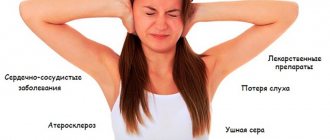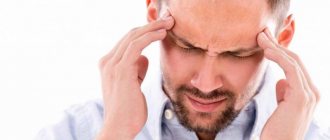Inflammation of the temporal artery
Symptoms:
- Severe, throbbing pain that appears suddenly and is localized mainly in the temples and back of the head.
- Pain occurs when chewing, moving the jaw and head, for example, when scratching; Along with general painful sensations, there is severe pain and pressure in the temples.
- Redness, a clearly noticeable hard stripe on the temples in the ear area.
- It hurts in the eyes, there is double vision and blindness (sometimes temporary, sometimes long-term) in one or both eyes.
- High fever, weight loss, and general weakness may appear.
- Sometimes I feel dizzy.
Diagnostics
Before starting active treatment of the pathology, it is necessary to identify the original cause that led to this condition. The patient should visit a therapist, otolaryngologist, neurologist, cardiologist. And if necessary, a surgeon and oncologist.
In addition to the survey and examination, you will be assigned various research techniques:
- General blood analysis. Provides information about the presence of inflammatory reactions in the body.
- Swabs from the mucous membranes of the nose and throat to identify the pathogen. This event is carried out to better select antibiotics for sinusitis and sinusitis.
- Ultrasound with Dopplerography of the vessels of the neck and head. Allows you to find deviations in the development and functionality of the vessels that supply the brain. Possible atherosclerotic deposits are also identified. Blood flow is visible in both directions.
- CT and MRI. These studies may be prescribed if previous methods are not informative or do not reveal any abnormalities. CT scans of the head can reveal even the smallest tumors, such as a neuroma (a growth on the auditory nerve).
Sources
- https://BezDavleniya.ru/obshhie/davlenie-v-ushax.html
- https://LechiOtit.ru/uho/simptomy/davlenie-v-ushah.html
- https://nashedavlenie.ru/sostoyaniya/davit-na-ushi.html
- https://ProLor.ru/u/simptomy-u/davit-na-ushi-iznutri-prichiny.html
- https://BolitGolova.info/golovnaya-bol/davit-na-ushi-iznutri-prichiny.html
- https://FB.ru/article/307292/davit-na-ushi-iznutri-prichinyi-i-lechenie-zalojilo-uho—chto-delat-v-domashnih-usloviyah
Course of the disease
The inflammation affects one or more arteries in the temples, most often the main temporal artery.
The reasons why the disease occurs are unknown, but the influence of heredity, viral origin or immune defects is indicated. Often the disease occurs together with polymyalgia rheumatica, a disease characterized by morning sickness and stiffness of muscles and joints. Symptoms may appear suddenly or develop gradually. Sometimes a small part of the artery in the temples is affected, in other cases the aorta (the largest artery in the body that comes from the heart), heart and carotid arteries are affected. The pain is induced mainly by the illuminated vessel wall, but there is a gradual narrowing of the arteries of pain, ischemia and lack of oxygen.
Sometimes there is spontaneous improvement, but deterioration is also possible: due to the interruption of blood flow to the optic nerve, blindness can occur.
Treatment
The main treatment is corticosteroids.
The doctor usually starts therapy with 40-60 mg daily dose of Prednisolone, which is divided into 2-4 doses. If the symptoms (severe headache, pressure in the temples) subside (usually within a few weeks), you can take the medicine only in the morning. As the condition stabilizes, the dose is gradually reduced. The goal of therapy is to free the patient from taking corticosteroids so that the disease does not relapse.
Treatment usually lasts about 1-2 years, sometimes much longer. Prednisone and other corticosteroids cause a number of side effects, such as weight gain, bone loss, high blood pressure, bruising, cataracts, and mood swings.
Necessary examinations
The list is quite long. Among the techniques:
- Consultations with specialists. A therapist, a neurologist and a cardiologist at a minimum. Further according to need.
- Oral questioning and history taking as a logical continuation of the previous point.
- General examination of blood and urine.
- Hormone tests. Including the reproductive, thyroid and adrenal glands. Also the pituitary gland.
- ECG.
- Echocardiography.
- Blood pressure measurement is routine.
- 24-hour Holter monitoring.
- Encephalography.
- MRI of the brain. With and without gadolinium contrast enhancement.
Pressure in the temples is almost always a symptom of illness. A thorough examination is necessary. Treatment is prescribed according to need.
Tinnitus and temple headaches
There is pressure on the temples, a headache and noise in the ears – is there a connection?
Tinnitus (tinnitus) is often accompanied by a condition in which there is headache (particularly in the temples), since, as a rule, both problems have the same underlying cause - stress. However, when tinnitus is associated with a temporary headache that originates from the temporal bone, has quite complex anatomical structures and is located above the ear, thus directly related to hearing, the problem must be specifically addressed.
Which doctor should I contact?
First, it is recommended to contact a therapist, pediatrician or otolaryngologist. The doctor will listen to the patient’s complaints and prescribe the necessary tests, based on the results of which he will determine the nature of the problem and refer him to a specialist. After this, treatment can be carried out by a neurologist, cardiologist, endocrinologist, vertebrologist and other doctors, depending on the cause of the noise.
Why does tinnitus occur with headaches in the temples, and what to do about it?
Factor #1 – stress
Stress is often responsible for conditions where there is ringing in the ears and headaches (mainly in the temporal region).
The pain is not so severe as to prevent a person from doing something, but there is little pleasure in it. High levels of ongoing stress and anxiety in people whose profession involves talking on the phone constantly puts them at risk, and they are the most vulnerable to developing tinnitus.
Medicines and sedatives can relieve symptoms, but on the other hand, they have many side effects.
Factor No. 2 – insomnia
Some case studies point to lack of sleep as a trigger for the development of tinnitus.
Often, due to international business trips, people experience lack of sleep due to time zone changes; they are most at risk of becoming victims of this disease. Call center workers who frequently miss sleep due to shift work also often report conditions that include ringing in the ears, pressure in the temples and headaches. True, in case of physical discomfort due to the above reasons, there is no need to do anything or take medications. Relief will come when a person rests for at least 7 hours.
Factor No. 3 – subarachnoid hemorrhage
We are talking about bleeding into the space between the brain, which can occur spontaneously due to a burst cerebral aneurysm or severe traumatic brain injury. However, such cases are rare, accounting for about 1 in 15,000 cases of tinnitus today.
Factor No. 4 – spinal tap
A lumbar puncture is a test in which cerebrospinal fluid is collected using a needle. After it, a severe headache may appear, lasting up to 12 hours after the procedure. The painful sensations are very intense, preventing the person from doing practically anything.
Reasons why there is pressure on the ears
Statistics show that more than thirty percent of the population complains of various ear-related problems. People sometimes have pressure on their ears and the reasons for this can be very diverse. In this case, it is better to consult a doctor, especially if the unpleasant symptom is severe and occurs repeatedly. Why do unpleasant sensations arise?
Symptoms that accompany pressure on the ears
An unpleasant sensation can occur in both a small child and an elderly person. Typically, the causes have nothing to do with age, with the exception of age-related tissue degeneration and hearing and vascular disorders.
When a person experiences squeezing pain, stuffy ears and bloating occurs, all this is not a specific symptom of any disease. This problem can have either one specific cause or entire groups.
Pressing pain in the ear from the inside can occur at absolutely any age
When visiting a doctor, patients often complain of the following symptoms:
- Feeling as if ears are completely closed. Some people experience congestion on one side, while others experience congestion on both sides.
- Headache. The intensity of the headache in each individual case may vary. The nature of the pain can be either dull or sharp. The pain can be localized in any part of the head. The frequency of pain can vary until it becomes chronic.
- Dizziness. The symptom may take on a permanent form, or may occur with sudden movements or ordinary turns.
- Movement coordination is impaired.
- Stuffy nose. Sore throat can occur due to inflammation of the upper respiratory tract. Often, rhinitis and pharyngitis can be accompanied by pain in the head and a squeezing sensation in the ears.
- Problems with walking and balance.
- Nausea, which in rare cases is accompanied by vomiting.
- Hearing impairment.
- Dry cough.
- Strong reaction to loud sounds and bright colors.
- Pain in the heart and chest area.
- The patient hears non-existent sounds.
If symptoms occur, you should consult a doctor to determine the cause and make a diagnosis.
Why does pressure occur in the ears?
Let's look at the most common reasons:
- Migraine. In this case, the pain will be long-lasting. Despite the prevalence of this disease, its true causes are still not fully understood, and control methods have not been determined. The pain often radiates to the temples or the back of the head and can persist for several weeks or even months. Conventional analgesics do not relieve pain, and bright light can be very irritating.
- Increased intracranial pressure.
- Disorders of the auditory nerve, in particular the appearance of neoplasms.
- Atherosclerosis.
- Acute and chronic otitis. During the inflammatory process, secretions, such as pus, accumulate in the middle ear, which causes a feeling of pressure.
- Osteochondrosis. With cervical osteochondrosis, the vessels and arteries that lead to the brain are pinched or even injured.
- Violation of the vascular system, which entails the appearance of other symptoms: deterioration of memory, vision and hearing, clouding of consciousness, headaches, heaviness in the head.
- Arterial hypertension can lead to spasm of the cervical vessels. Patients develop headaches.
- Adenoiditis.
- Pregnancy.
- Hearing loss.
- Diving to depth.
- The effect of certain medications.
- Frequent use of headphones, earplugs, and long conversations on the phone.
- Presence of sulfur plug. Earwax buildup can completely block the ear canal.
Separately, I would like to mention changes in atmospheric pressure. Ascents and descents from mountains, airplane flights - all this leads to the pressing of the eardrum into the ear canal, which causes discomfort in the ear. Chewing gum or sucking candy will help get rid of the unpleasant symptom.
If there is pressing pain in the ears, you should consult an ENT doctor
What can you do
If you notice pressing pain in the ears, persistent symptoms that persist over a long period of time, you must undergo a comprehensive examination. A visit to an otolaryngologist is the first stage of a diagnostic study.
An ENT specialist checks for inflammation in the ears, injuries and various pathological processes. The otolaryngologist will determine whether the cause of pressure in the ears is the presence of wax plugs or a more serious reason. With the help of an audiogram, the otolaryngologist will be able to see whether hearing function is impaired.
The problem can be suppressed with the help of medications, which include:
- painkillers;
- antibiotics;
- vitamin complexes;
- restoratives.
Physiotherapeutic procedures speed up the healing process and relieve excruciating pain
The diagnostic testing that needs to be done includes the following:
- scanning of cerebral vessels;
- MRI;
- ultrasound examination of the neck;
- X-ray examination of the spine;
- measurement of intracranial and blood pressure.
Let's take a closer look at effective diagnostic testing methods:
- Otoscopy. This method helps to identify the presence of cerumen, symptoms of otitis media or damage to the eardrum.
- metric The technique allows you to determine how the patient hears sounds of different frequencies.
- Tympanometry evaluates the condition of the auditory ossicles, auditory tubes and inner ear.
- Radiography is used despite its low effectiveness in the study of hearing impairment. X-ray examination allows you to determine intracranial pressure and identify sinusitis - common causes of squeezing sensations in the ear.
- CT and MRI can identify inflammatory processes, developmental abnormalities, and neoplasms.
- A general blood test allows you to determine the intensity of the inflammatory process and its nature: acute or chronic.
- Regular blood pressure measurements can detect hypertension.
Treatment depends on the underlying cause that caused the pressure on the ears
If the whole point is arterial hypertension, then the first step is to normalize the pressure. If you have suffered from hypertension for a long time, then stuffy ears and headaches should serve as an alarming signal. Blood pressure medications should be taken regularly as prescribed by your doctor.
If the cause of the compressive pain is an acoustic neuroma, then, as a rule, surgical treatment is prescribed. An alternative technique is radiation therapy, which is prescribed in the following cases:
Dizziness and whistling in the ears
- inconvenient location of the tumor;
- large tumor size;
- existing contraindications to surgical treatment.
It happens that simple rest eliminates an unpleasant symptom. Pressure in the ears can be a clear sign of fatigue. You should definitely get enough sleep, walk in the fresh air and take your mind off your worries.
If the main problem is a cold, then it does not require specific treatment. Symptomatic treatment is carried out: antipyretic drugs, analgesics, antiviral drugs, etc. It is important to strengthen the immune system, because it will help cope with the disease.
The entry of water into the ear canal can provoke the development of an inflammatory process, so it must be removed as soon as possible. This can be done by tilting your head to the affected side; if this does not help, you can jump. If your attempts are unsuccessful, you must go to the hospital.
You can do without medications, but only if the true reasons are known. Non-traditional methods are safe and are often used to treat pregnant women and children. Consider popular traditional medicine recipes:
- if the whole problem lies in the formation of a cerumen plug, then you can drip hydrogen peroxide into your ear to soften it, and then rinse it;
- in case of inflammation, rosehip oil and anise oil help;
- when there is a difference in atmospheric pressure, you need to swallow as much as possible to release saliva and relieve ear pressure;
- if the problem is a foreign object getting into the ear, vegetable oil should be dropped into the ear, and then rinsed.
Traditional methods can be dangerous if used incorrectly. Any measures must be agreed with a doctor
Prevention
It is easier to prevent a disease than to treat it. Let's look at some simple tips to help reduce the risk of ear pressure:
- active lifestyle;
- balanced diet;
- timely treatment of upper respiratory tract diseases;
- giving up bad habits, in particular smoking and alcoholic beverages;
- hygiene of the external auditory canal;
- timely treatment of adenoiditis.
When diving under water, you should choose the optimal speed at which the body would adapt to the change in pressure
So, compressive pain in the ears can appear due to a variety of reasons, which must be determined by a specialist. Self-medication can lead to serious complications, so diagnosis should be carried out by a qualified otolaryngologist.
Source: https://superlor.ru/diagnostika/prichiny-kotorym-davit-ushi
Tinnitus, headache and temple pressure: secondary factors
Contrary to early claims that explained unpleasant episodes of tinnitus as “all due to stress,” it is now known that a family history or group of conditions known as temporomandibular disorders (TMDs) may be responsible for tinnitus.
It was also found that headaches and tinnitus are symptoms of the disorder, not the disorder itself. That is why treatment of these symptoms will be most effective if you begin therapy with the treatment of VNR.
In addition to the fact that the temporomandibular joint is located very close to the human ear, there are a group of mechanisms that cause the symptoms to appear. For example, the nerve muscles that are directly connected to the ear originate at the intersection of the nerves that serve the muscles of mastication. With this arrangement, it is easy to predict that a slight disorder could lead to changes in the muscles associated with the ear. It has been observed that certain types of ototoxic drugs that contain antibiotics such as aminoglycosides, vancomycin and erythromycin, quinine, and chemotherapy may be responsible for tinnitus and cause unpleasant temple headaches in older age group. The toxins present in most of these medications cause irritation in the temporal part of the skull and thus stimulate pain and discomfort in this area.


